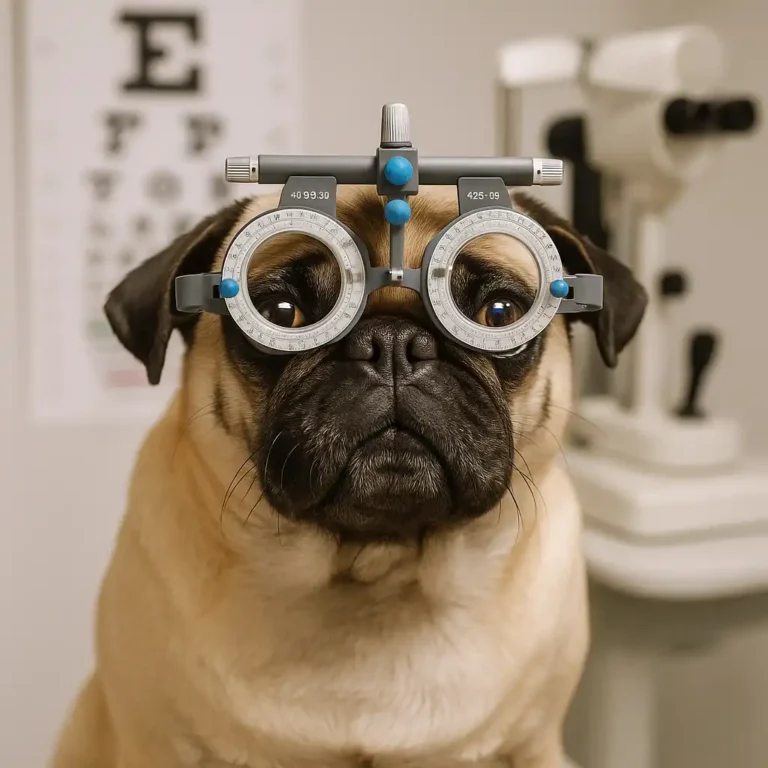Why Do Pugs Have Breathing Problems? Understanding Flat-Faced Anatomy and Airway Issues

Disclosure: This post contains affiliate links. As an Amazon Associate, I earn from qualifying purchases—at no extra cost to you.
Last Updated: December 2025
Pugs are loved for their flat faces, big eyes, and unmistakable snorts—but those same features are also why many pugs struggle with breathing problems. It’s common for owners to notice noisy breathing, snoring, or shortness of breath during everyday moments, even when their pug hasn’t been very active.
Understanding why pugs have breathing issues helps you tell the difference between normal breed traits and signs that deserve closer attention. It also makes daily care decisions—like exercise, heat exposure, and rest—much easier to manage.
👉 For a broader look at common health issues that affect the breed, this guide to common pug health concerns explains how breathing issues, heat sensitivity, and other problems are connected: see the full pug health overview.
🔍 Why Pugs Have Breathing Problems in the First Place
The main reason pugs struggle with breathing is their brachycephalic anatomy. Brachycephalic breeds have shortened skulls that compress the nasal passages and throat, reducing how freely air can move in and out.
In pugs, this often includes narrow nostrils, an elongated soft palate, and a windpipe that’s smaller than average for their body size. Together, these traits make breathing less efficient, especially during excitement, physical activity, or warm weather.
🔍 What Is Brachycephalic Airway Syndrome?
Many pug breathing problems fall under brachycephalic airway syndrome, which refers to a group of airway abnormalities rather than a single condition.
This can involve narrowed nostrils and soft palate tissue that partially blocks airflow. Because these features are inherited, most pugs experience some degree of breathing difficulty throughout their lives—even when they’re otherwise healthy.
🔍 Why Pugs Snore, Snort, and Breathe Loudly
Snoring and snorting happen because air has to pass through narrowed passages, causing vibration in the soft tissues of the nose and throat.
These sounds often become louder when a pug is sleeping, excited, stressed, or slightly overheated. Occasional noisy breathing is normal for the breed, but sudden changes in sound, frequency, or effort should always be monitored.
🔍 How Exercise and Heat Affect Pug Breathing
Breathing problems tend to worsen during exercise or in warm temperatures. Because pugs rely heavily on panting to cool themselves, restricted airways make temperature regulation harder.
You may notice heavy panting after short walks, faster fatigue, or slower recovery after activity. Keeping exercise gentle and avoiding heat are key parts of managing pug breathing issues day to day.
🔍 When Breathing Problems Become a Health Concern
While noisy breathing is common for pugs, some symptoms point to more serious trouble. Persistent coughing, gagging, collapse after mild activity, blue or pale gums, or labored breathing at rest all warrant veterinary attention.
These signs may indicate significant airway obstruction and should never be ignored.
🔍 Can Pugs Live Comfortably With Breathing Issues?
Many pugs live happy, comfortable lives despite breathing challenges. Maintaining a healthy weight, limiting overexertion, and being mindful of heat exposure can make a noticeable difference.
With proper care and awareness of their limits, most pugs adapt well to their anatomy and enjoy a good quality of life.
📌 Key Takeaways
- Pugs have breathing problems mainly because of their flat, shortened facial structure
- Brachycephalic airway syndrome explains many common breathing symptoms
- Snoring and snorting are usually normal but should stay consistent
- Heat and exercise can worsen breathing difficulties
- Proper daily care helps most pugs live comfortably
🟢 FAQs
Q: Is it normal for pugs to breathe loudly?
Yes. Loud breathing, snoring, and snorting are common due to narrowed airways, though sudden changes should be monitored.
Q: Do all pugs have breathing problems?
Most pugs experience some level of airway restriction, but severity varies from dog to dog.
Q: Can pug breathing problems get worse with age?
Yes. Weight gain and aging can make breathing issues more noticeable over time.
Q: When should I take my pug to the vet for breathing issues?
If your pug has labored breathing, collapses, or shows blue or pale gums, veterinary care is recommended.
✅ Conclusion
Pugs have breathing problems primarily because of their brachycephalic anatomy, which naturally restricts airflow. While snoring and snorting are common traits of the breed, understanding the causes helps owners manage daily care and spot warning signs early. With attention to exercise, temperature, and overall health, most pugs can live comfortable and happy lives.






